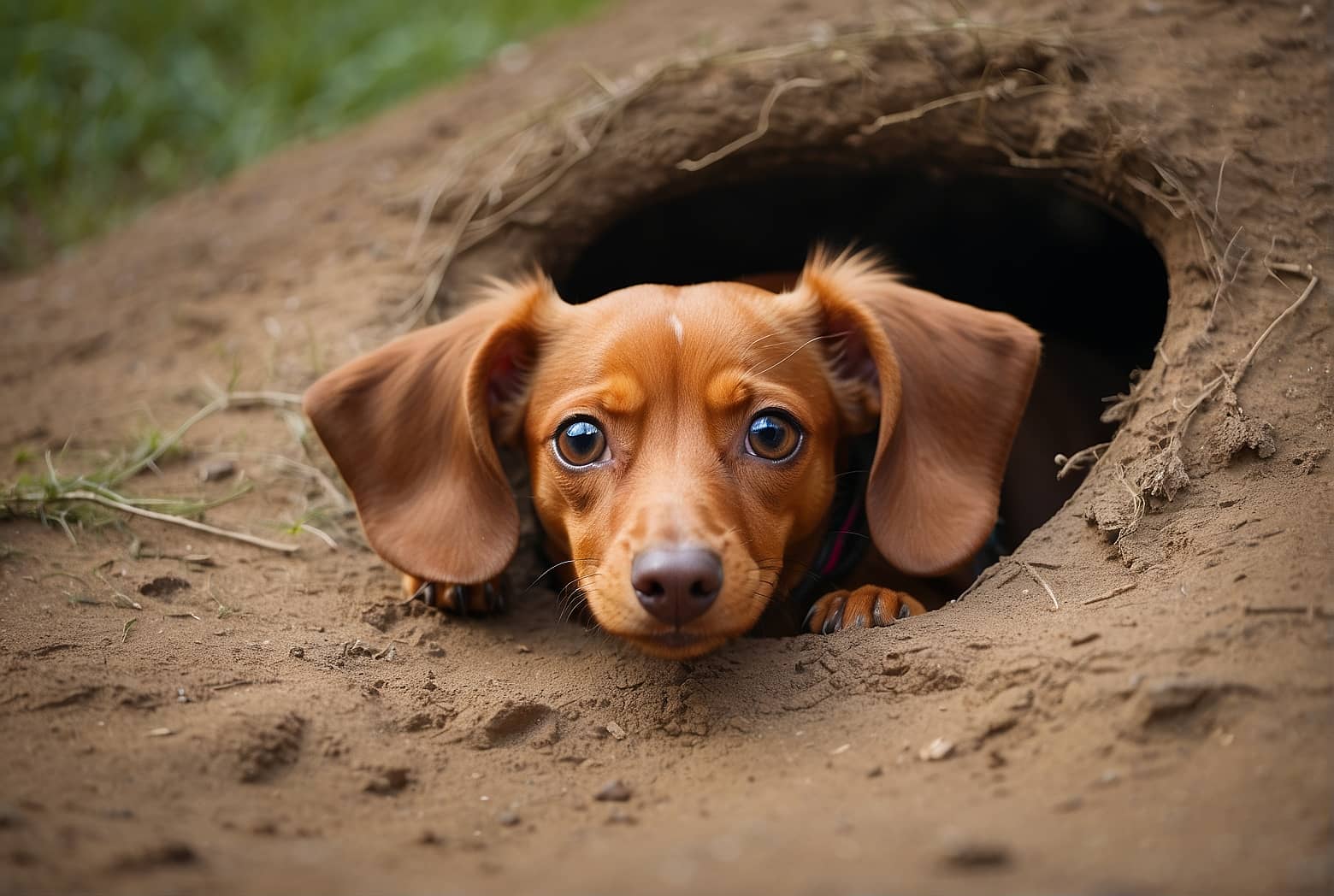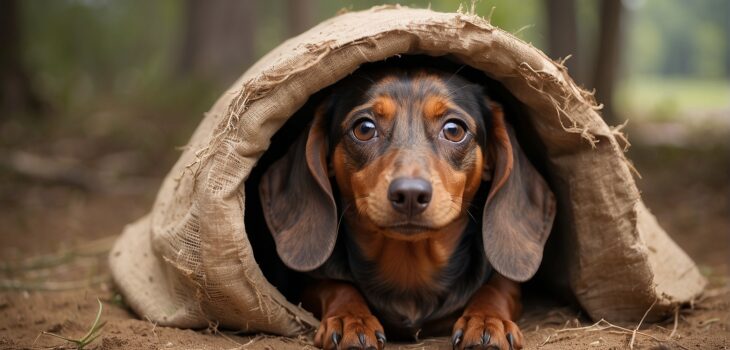Last Updated on April 23, 2024 by admin
If you’ve ever wondered why your Dachshund always seems to be digging and burrowing around the house, you’re not alone. Many Dachshund owners have observed this unique and endearing behavior in their furry companions. But why do Dachshunds like to burrow? In this article, we will explore the fascinating instinctual reasons behind this behavior and shed light on the connection between Dachshunds and their natural digging tendencies. From exploring their ancestral roots to understanding the comfort and security they seek, prepare to unravel the mysteries behind your Dachshund’s love for burrowing.
What is burrowing?
Burrowing is a behavior commonly observed in many animals, including our beloved Dachshunds. It refers to the instinctive action of digging or creating a cozy space in which to nest or seek comfort. Burrowing can have various purposes, such as providing warmth, security, and relief from anxiety or stress.
Definition
Burrowing, in the context of Dachshunds, entails their natural inclination to dig and create tunnels or nests. This behavior is deeply ingrained in their instincts and has been passed down through generations.
Purpose of burrowing
The primary purpose of burrowing for Dachshunds is to create a safe and secure environment for themselves. By digging and nestling into confined spaces, they can find comfort, warmth, and a sense of protection. Burrowing also serves as a way for them to alleviate anxiety and stress, providing them with a much-needed sense of calm and reassurance.

Why do Dachshunds burrow?
Natural instinct
Dachshunds have a strong natural instinct to burrow, which stems from their ancestry as hunting dogs. Their instincts drive them to create tunnels and dig into the earth in search of prey or to flush out animals from their hiding places.
Historical use in hunting
Dachshunds were specifically bred for hunting small game, such as badgers and rabbits, which often retreat into burrows or underground tunnels. Their ability to burrow efficiently allowed them to navigate through tight spaces and flush out the prey. This ingrained hunting instinct has remained a prominent characteristic in Dachshunds, even though they are now primarily kept as family pets.
Seeking comfort and security
Apart from their hunting heritage, Dachshunds also burrow for more mundane reasons such as seeking comfort and security. Burrowing provides them with a sense of coziness and protection, replicating the feeling of being in a den or a safe space. This behavior is akin to finding solace in a warm blanket or snuggling up in a small, enclosed area.
Physical characteristics that make Dachshunds good burrowers
Long, low body shape
One of the most prominent physical characteristics of Dachshunds that contribute to their burrowing abilities is their long, low body shape. Their elongated spine and short legs enable them to navigate through narrow tunnels and dig into the ground with ease. This unique body structure allows them to excel in the burrowing behavior they are instinctively inclined towards.

Strong paws and claws
Dachshunds possess strong, sturdy paws equipped with sharp claws, which aid them in digging into the earth. These specialized paws and claws provide them with the necessary tools to create tunnels and nests effectively. Their determination and strength allow them to delve deep into the ground, further enhancing their burrowing capabilities.
Flexible spine
Another physical attribute that makes Dachshunds exceptional burrowers is their flexible spine. Their spine has the ability to bend and twist, granting them the agility required to maneuver through tight spaces and navigate underground. This flexibility allows them to adapt to varying terrains and ensures their success in their burrowing pursuits.
Signs that a Dachshund likes to burrow
Digging behavior
One clear sign that your Dachshund enjoys burrowing is their tendency to engage in digging behavior. If you notice your furry friend frequently digging or excavating holes in your yard, they are likely satisfying their innate burrowing instincts. This behavior is a natural expression of their desire to create a safe and cozy space for themselves.
Preference for confined spaces
Dachshunds that have a penchant for burrowing often display a preference for confined spaces. They may seek out small, enclosed areas like under furniture, blankets, or even inside pillows. Their desire to be in close quarters reflects their inclination towards finding secure spaces that mimic the feeling of being underground or within a burrow.
Nesting and tunneling
Another notable sign that your Dachshund enjoys burrowing is their nesting and tunneling behaviors. You may observe them diligently shaping their bedding or gathering blankets to create a snug and secure nest. They may also exhibit behaviors such as attempting to tunnel through pillows or blankets, trying to create their own little burrow within the comfort of your home.
Benefits of burrowing for Dachshunds
Staying warm and cozy
Burrowing provides Dachshunds with a practical benefit of staying warm and cozy. Their low body shape allows them to burrow deep into blankets or beds, trapping their body heat and creating a warm sanctuary. This is particularly beneficial during colder seasons or for Dachshunds living in chillier climates, as it helps them regulate their body temperature and find comfort in their burrow-like nests.
Feeling safe and protected
For Dachshunds, burrowing represents a way to feel safe and protected. The act of digging into the ground or nestling into confined spaces mirrors the security of a den or a burrow in the wild. By engaging in this behavior, Dachshunds can ease their anxieties and seek refuge in a familiar and enclosed space, providing them with a sense of protection and tranquility.
Relieving anxiety and stress
Burrowing acts as a natural stress relief mechanism for Dachshunds. By burrowing, they can channel their energy into a constructive activity that helps them relax and unwind. The physical and mental stimulation created through the process of digging and nestling offers a therapeutic outlet for their anxieties, helping to alleviate stress and promote overall well-being.
Creating a burrowing-friendly environment for Dachshunds
Providing designated burrow spaces
To cater to your Dachshund’s burrowing instincts, it is important to provide them with designated burrow spaces. This can include introducing a designated area in your home where they can freely dig and burrow, such as a sandbox or a dirt patch in your yard. By offering a specific space for this behavior, you can redirect their burrowing tendencies and satisfy their natural instincts.
Using burrow-like bedding
Choosing suitable bedding for your Dachshund is key to creating a burrow-friendly environment. Opt for blankets or beds that are soft, cozy, and able to be shaped or molded to create a nest-like space. Bolster beds or cave-like designs can particularly cater to their desire for confinement and provide an ideal setting for them to indulge in their burrowing behavior.
Ensuring safety and comfort
While encouraging your Dachshund’s burrowing behavior, it is crucial to ensure their safety and comfort. Avoid using materials that may pose choking hazards or be harmful to them if ingested. Regularly inspect burrow spaces to prevent any potential dangers, and provide proper ventilation if they choose to burrow within blankets or enclosed areas. Prioritizing their well-being will help create a secure and enjoyable burrowing environment.
Burrow-like products for Dachshunds
Burrow beds
Burrow beds are specifically designed to cater to a Dachshund’s burrowing instincts. These beds often feature soft, cozy fabrics that can be easily manipulated to create a nest-like space. Some burrow beds even have built-in tunnels or pockets, which provide an additional element of comfort and mimic the feeling of being in an underground den.
Blankets and tunnels
Blankets and tunnels can be excellent additions to a Dachshund’s burrow-friendly environment. Incorporating soft and warm blankets allows them to create cozy spaces to nestle and burrow into. Tunnels, whether store-bought or homemade, provide an interactive and engaging way for Dachshunds to indulge in their burrowing behavior and explore their surroundings.
Burrow toys
Burrow toys are innovative products designed specifically for Dachshunds to engage in their burrowing behavior while providing mental stimulation. These toys usually consist of plush objects or hide-and-seek puzzles, containing smaller objects or treats that need to be “unearthed” or “discovered.” Burrow toys satisfy their instinctive need to dig and burrow while keeping them entertained and mentally engaged.
Training a Dachshund to use a burrow bed
Introduction and positive reinforcement
Introducing a burrow bed to your Dachshund requires patience and positive reinforcement. Start by placing the bed in an area where they frequently rest or display burrowing behaviors. Encourage them to explore the bed by using verbal cues and offering treats or praise when they show interest. Gradually increase their exposure to the burrow bed, ensuring they associate it with positive experiences and comfort.
Encouraging exploration and nesting
To encourage your Dachshund to use the burrow bed, sprinkle treats or place their favorite toys inside to entice them. You can also gently guide them into the bed or use a verbal cue to associate the bed with their burrowing behavior. If they start to burrow or settle into the bed, reward them with praise or treats. The goal is to foster a sense of comfort and security in the burrow bed.
Gradual transition from traditional bed
If your Dachshund is accustomed to sleeping in a traditional bed, transitioning them to a burrow bed may require a gradual approach. Start by placing their current bed near the burrow bed, allowing them to familiarize themselves with the new scent and presence. As they grow more accustomed, you can gradually move their bedding into the burrow bed or replace their traditional bed altogether. Patience and positive reinforcement are key to success during this transition.
Potential risks and precautions of Dachshunds burrowing
Getting stuck or trapped
One potential risk of Dachshunds burrowing is the possibility of getting stuck or trapped. Their determination to dig and burrow may result in them squeezing into tight spaces or creating tunnels that prove difficult to escape from. To prevent this, it is vital to ensure their burrow spaces are safe, well-monitored, and free from potential hazards that could put them at risk.
Overheating in confined spaces
While Dachshunds enjoy the warmth and coziness of burrowing, it is essential to monitor their safety in confined spaces. Dogs burrowing in enclosed areas like blankets or beds may be at risk of overheating, especially during warmer weather. It is crucial to provide proper ventilation and ensure they have access to cooler areas or adjust their surroundings to maintain their comfort and prevent overheating.
Monitoring for excessive digging
While burrowing is a natural behavior for Dachshunds, excessive digging can lead to complications. Excessive digging may damage your home or yard, cause injury to your Dachshund’s paws, or indicate underlying anxiety or stress. Monitoring their digging behaviors and providing appropriate outlets for their energy and instincts can help prevent any negative repercussions.
Conclusion
Understanding and embracing Dachshunds’ burrowing behavior is crucial for providing them with a happy and fulfilling life. Burrowing is a natural instinct deeply rooted within their genetics, and it serves various purposes, from ensuring warmth and comfort to relieving stress and anxiety. By acknowledging their inclination to burrow and creating a burrow-friendly environment, you can enhance their overall well-being and strengthen the bond you share with your Dachshund. So, embrace their burrowing tendencies and ensure they have plenty of opportunities to dig, nestle, and find solace in their cozy burrows.




